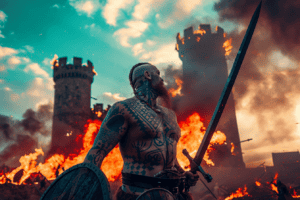Yggdrasil, the immense and sacred tree of Norse mythology, stands as a central pillar in the Viking worldview. This vast ash tree stretches its branches into the heavens and extends its roots deep into the earth, interconnecting the Nine Worlds of Norse cosmology.
Yggdrasil’s presence is more than symbolic; it embodies the complex relationships and interactions between gods, giants, and humans.
Within its branches lies the wisdom of ages, and its roots touch the wellsprings of knowledge and destiny.
Through Yggdrasil, the intricate web of Norse mythology is woven, linking the realms of Asgard, Midgard, and Niflheim, among others. This ancient tree not only serves as the axis of the cosmos but also as a testament to the enduring power and mystery of the Norse sagas.
What Exactly Is Yggdrasil?

In Norse mythology, Yggdrasil, the cosmic tree, symbolizes the interconnectedness of the nine worlds.
This magnificent tree connects various planes of existence, playing a crucial role in maintaining the balance of the universe. Each of the nine worlds, with its unique inhabitants and landscapes, is unified through the branches and roots of Yggdrasil.
Yggdrasil’s significance goes beyond being just a physical entity. It embodies the cosmic order and reflects the cyclical nature of life, death, and rebirth. Its roots delve deep into the Well of Urðr, where the three wise Norns shape fate itself.
Yggdrasil vividly portrays the interconnectedness of all things in the cosmos, highlighting the inseparable link between the worlds and the delicate balance that must be maintained.
The Structure of Yggdrasil
Nestled within the fabric of Norse mythology lies the intricate and enigmatic structure of Yggdrasil, the cosmic tree that binds the Nine Worlds in a web of interconnectedness.
The roots of Yggdrasil penetrate deeply into various domains, symbolizing its profound connections to different aspects of the cosmos. These roots reach into domains such as Asgard, Jotunheim, and Hel, embodying the tree’s role as a central axis in Norse cosmology.
The branches of Yggdrasil stretch far and wide, reaching across the expanse of the Nine Worlds and providing a link between them. These branches symbolize the interconnected nature of existence in Norse mythology, highlighting the unity of all realms through the cosmic tree.
In Norse cosmology, Yggdrasil stands as a powerful symbol of the universe’s structure and order. Its roots and branches serve as a metaphor for the intricate connections that tie together the fabric of reality, representing the interwoven nature of existence in the mythological world of the Norse.
Yggdrasil and Its Inhabitants

Tended by the three Norns from the Well of Urðr, Yggdrasil is home to a diverse array of mystical beings and creatures, each playing a unique role in the intricate ecosystem surrounding the Cosmic Tree.
The Norns weave the destinies of all beings in the Nine Worlds, ensuring the balance of fate. Among Yggdrasil’s inhabitants is the malevolent serpent Níðhöggr, who gnaws at the tree’s roots, symbolizing chaos and destruction.
This serpent’s presence highlights the constant threat that looms over Yggdrasil, emphasizing the fragility of cosmic order.
Odin’s sacrifice on Yggdrasil stands as a proof to the tree’s significance in Norse mythology. By hanging himself from the branches for nine days and nights, Odin gained immense wisdom and insight. This act underscores the deep connection between the tree, knowledge, and the divine.
In addition to Níðhöggr, other unique beings like Ratatoskr, the squirrel messenger, and the roosters heralding Ragnarök, populate the branches and roots of Yggdrasil.
Their presence adds layers of complexity to the already intricate tapestry of Norse mythology, showcasing the rich and diverse inhabitants of the Cosmic Tree.
Yggdrasil and the Nine Worlds

Extending its branches throughout the domains of Asgard, Midgard, Vanaheim, and Jotunheim, Yggdrasil intertwines the Nine Worlds in Norse mythology, serving as the cosmic axis that connects gods, giants, and humans.
The nine domains, including domains of gods, giants, and humans, are all linked by the vast cosmic ash tree. Yggdrasil’s roots dig deep into the wells of wisdom, providing nourishment to the interconnected web of the Nine Worlds.
This ancient tree acts as a central axis, embodying the interconnectedness of the cosmos and the diverse domains of Norse mythology. Through its branches reaching far and wide, Yggdrasil facilitates travel between different worlds for the beings that inhabit them.
The well of wisdom at its roots not only sustains the tree but also imparts knowledge and insight to those who seek it. As the central pillar of Norse cosmology, Yggdrasil stands as a symbol of the intricate relationship between the various domains and beings in the mythical universe.
Yggdrasil and the Norse Gods
Yggdrasil stands as the revered meeting place for the Norse gods, symbolizing their interconnectedness and influence across Asgard and beyond.
This cosmic tree serves as a central hub where deities like Odin, Thor, and Frigg gather to discuss important matters and maintain the balance of power. Odin’s sacrifice on Yggdrasil, where he hung for nine days and nights, highlights the tree’s profound significance.
During this sacrifice, Odin gained wisdom and knowledge of the runes, enhancing his divine capabilities and cementing Yggdrasil’s importance in Norse mythology.
The Norse gods frequently convene around Yggdrasil to share knowledge, make decisions, and engage in activities that affect the Nine Worlds.
Their interactions with the cosmic tree are woven into various myths and stories, showcasing the deep-rooted connection between Yggdrasil and the gods. As the meeting point for the deities, Yggdrasil plays a vital role in shaping the destiny of the Norse gods and the worlds they oversee.
Yggdrasil and Ragnarok

As the apocalyptic event of Ragnarok approaches in Norse mythology, the fate of Yggdrasil, the cosmic tree, symbolizes the impending end of the world.
During Ragnarok, Yggdrasil faces destruction and upheaval, reflecting the cyclical nature of existence in Norse beliefs.
This interconnectedness of life and death is vividly portrayed as Yggdrasil serves as a sanctuary amidst the chaos, offering a glimmer of hope for renewal and rebirth.
Ragnarok marks a cataclysmic event where the old world perishes to make way for a new one. Yggdrasil’s role in this cosmic upheaval underscores the notion of interconnectedness, showing how even the world tree is subject to the cycles of creation and destruction.
As the threads of fate are woven and unwoven during Ragnarok, Yggdrasil stands as a poignant symbol of the enduring resilience and transformative power within the cyclical tapestry of existence.
Symbolism and Meaning of Yggdrasil
Symbolizing profound interconnectedness, the cosmic tree Yggdrasil holds significant symbolism and meaning within Norse mythology.
Known as the Tree of Life, Yggdrasil represents the interconnected nature of the cosmos and all life. Its roots reach deep into wells of wisdom, embodying the knowledge that sustains and connects all existence.
The tree’s branches stretch across the domains, illustrating the cycle of life, growth, decay, and rebirth. This cycle reflects universal truths about existence and the interconnectedness of all beings.
Within Yggdrasil, various creatures reside, each symbolizing different aspects of life and existence in Norse mythology.
As a meeting point for gods and creatures, Yggdrasil emphasizes the diverse and interconnected nature of existence. The tree stands as a powerful symbol of the cosmic order, reminding us of the intricate web that connects all living beings in a continuous cycle of life and renewal.
Yggdrasil in Popular Culture

In contemporary culture, the influence of Yggdrasil, the cosmic tree from Norse mythology, extends far beyond ancient tales and legends. References to Yggdrasil can be found in various forms of popular media, showcasing its enduring relevance and spiritual depth.
Video games like ‘God of War‘ and ‘Assassin’s Creed Valhalla’ incorporate the cosmic tree, giving players a taste of Norse mythology.
In modern literature, authors like Neil Gaiman in ‘Norse Mythology’ keep the tradition alive by featuring Yggdrasil prominently. The symbolic significance of Yggdrasil transcends into music, with bands such as Wardruna drawing inspiration from its themes in their songs.
Moreover, the tree’s imagery is popular in tattoos and artwork, reflecting its deep-rooted importance in Norse mythology.
Yggdrasil’s presence as a recurring motif in fantasy novels, like Rick Riordan‘s ‘Magnus Chase’ series, further solidifies its place in popular culture and underscores the enduring fascination with the rich tapestry of Norse mythological traditions.










Add Comment